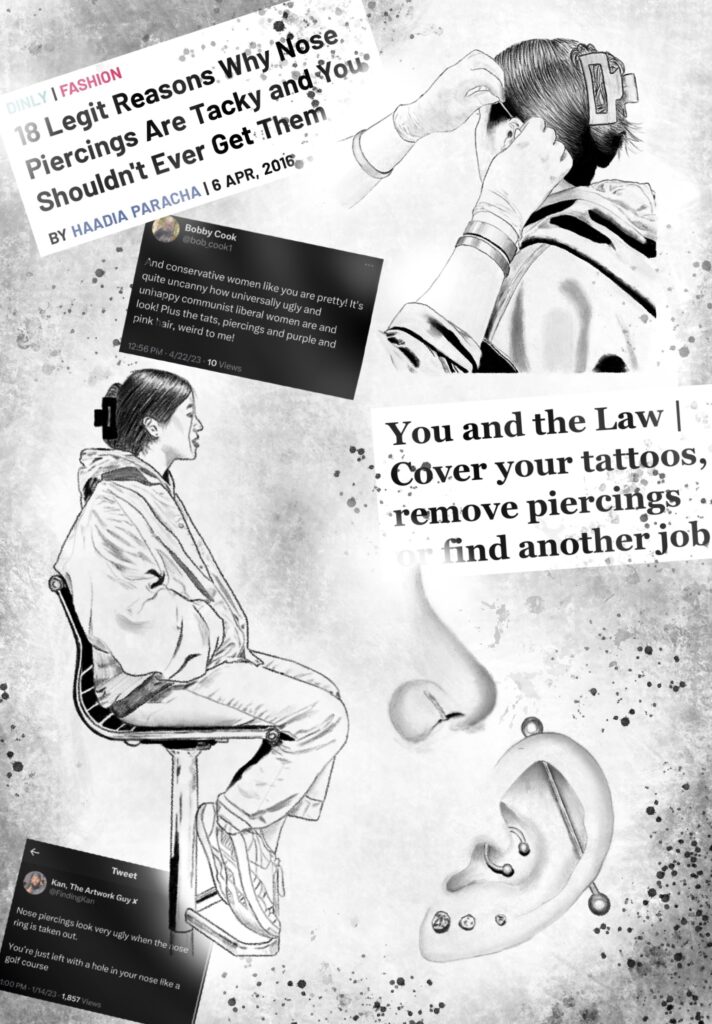
When I asked to get my nose pierced for my 17th birthday, I shouldn’t have been surprised when my mom said no. My dad took me instead. My mom wasn’t terribly opposed but went on to explain that I shouldn’t get any more obvious piercings if I want to look employable. Now, with 13 piercings and counting, my mom could not be more displeased. I know this sounds like a story of a typical teenager who wants nothing more than to defy my parents and rebel against social norms, but why can’t I get piercings just for the sake of liking how they look? While my mother considers my piercings as symbols of rebellion, I like them because they allow me to feel unique and confident which is a common motivation for many college-aged youth (Tiggemann 2011). While piercings in the United States have rebellious roots, the rationales behind them have become more concerned with self-expression rather than opposing social norms for many (Armstrong et al 2004).
A Brief History of Piercings
Piercings as a form of body modification in the ears, nose, and mouth have been documented around the world throughout history as far back as can be traced (Stirn 2003). Piercings are also a large symbol of culture and are practiced in many contemporary societies, specifically in Asia, Africa, and South America. Piercings in American culture are far less embedded and culturally significant and can be found in areas like the navel, eyebrow, and even genitalia. In the United States, piercings carried negative connotations, as those with piercings were parts of social movements in the 1970s and 1980s that rebelled against conservative, middle class norms.
Now, piercings, and body art in general are on the rise, but the academic literature is still hesitant and tends to focus on negative factors and stigmas like medical complications, risk-taking behaviors, reckless driving, drinking, marijuana use, and adverse personality traits (Coleman et. al 2011).
Piercings as a Means of Self-expression
Seeing as there are other means of self-expression like fashion, why do people continue to willingly subject themselves to pain just to wear some flashy jewelry? For some, piercings have a larger tie to identity; they allow people to express themselves and feel unique and have become more of a fashion accessory than anything else (Tiggemann 2011). An example of this lies in navel piercings. Especially amongst women, these have become common and have been tied to more positive self-perception, especially because the abdominal region is a place people “often feel negatively about” (Coleman et al. 2022). This rationale is related to aesthetics and self-perception rather than risk-taking behaviors or adverse personality traits.

Reasons for making a body art – National Library of Medicine 2011 https://www.ncbi.nlm.nih.gov/pmc/articles/PMC3196715/
Piercings Amongst College-Aged Youth
Body piercings have grown in popularity in recent years amongst a wide range of age groups and college students are no exception. 32% of college students reported currently having at least one piercing in 2004 (Armstrong et al. 2004). While some students with piercings have shown to have an increase in risk-taking behavior, there is little that distinguishes them from students without forms of body modification (Forbes 2001). Students with piercings come from similar family backgrounds, share similar experiences, and have similar rates of body satisfaction (Forbes 2001), meaning that there are more similarities than differences between students with piercings and those without. This also further indicates that the need to deviate from their social settings was not a popular reason that these students got pierced given that they were brought up under similar conditions, making their adverse reputations all the less warranted.
Going Forward
The reason people choose to get pierced goes much farther than social deviation and a desire to reject social norms. Piercings are tied to culture, body image, and provide feelings of uniqueness and independence to the bearer. Piercings can provide many more benefits besides aesthetics, and we should make ourselves aware of how body modification can affect our evaluations of ourselves and others to help erase any possible negative perceptions.
Works Cited
Armstrong, M. L., Roberts, A. E., Owen, D. C., & Koch, J. R. (2004). Toward Building a Composite of College Student Influences with Body Art. Issues in Comprehensive Pediatric Nursing, 27(4). https://www.tandfonline.com/doi/abs/10.1080/01460860490884183
Armstrong, M. L, Kelley, L. (2001). Tattooing, body piercing, and branding are on the rise: Perspectives for school nurses. The Journal of School Nursing, 17(1). https://journals.sagepub.com/doi/pdf/10.1177/105984050101700103
Armstrong, M. L., Roberts, A. E., Owen, D. C., & Koch, J. R. (2004). Contemporary college students and body piercing. Journal of Adolescent Health, 35(1), 58–61. https://doi.org/10.1016/S1054-139X(03)00338-0
Coleman, C., & Gillmeister, H. (2022). Body image and self-perception in women with navel piercings. PloS One, 17(9), e0274099–e0274099. https://doi.org/10.1371/journal.pone.0274099
Forbes, G. B. (2001). College Students with Tattoos and Piercings: Motives, Family Experiences, Personality Factors, and Perception by Others. Psychological Reports, 89(3), 774–786. https://doi.org/10.2466/pr0.2001.89.3.774
Stirn, A. (2003). Body piercing: medical consequences and psychological motivations. The Lancet (British Edition), 361(9364), 1205–1215. https://doi.org/10.1016/S0140-6736(03)12955-8
Tiggemann, M., & Hopkins, L. A. (2011). Tattoos and piercings: Bodily expressions of uniqueness? Body Image, 8(3), 245–250. https://doi.org/10.1016/j.bodyim.2011.03.007